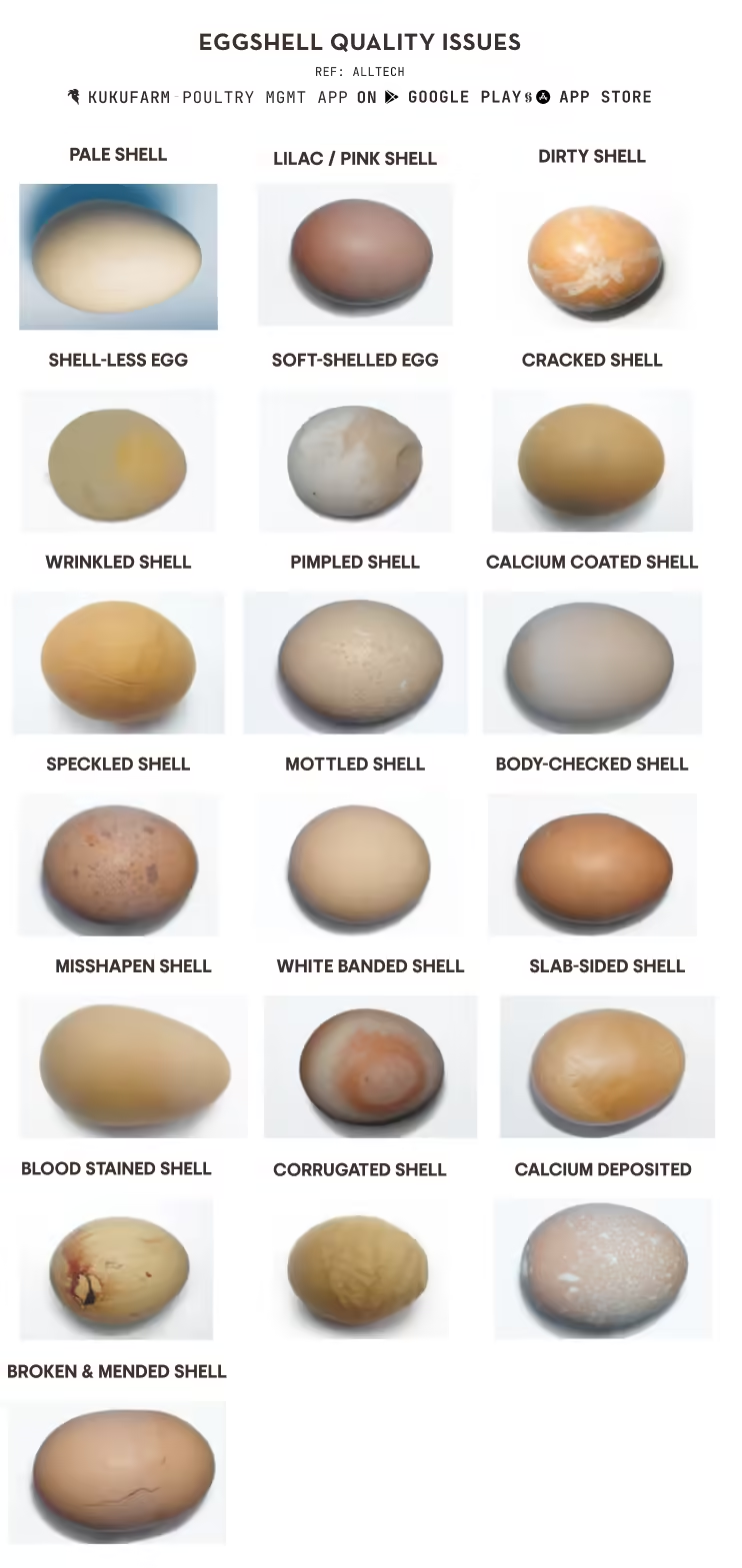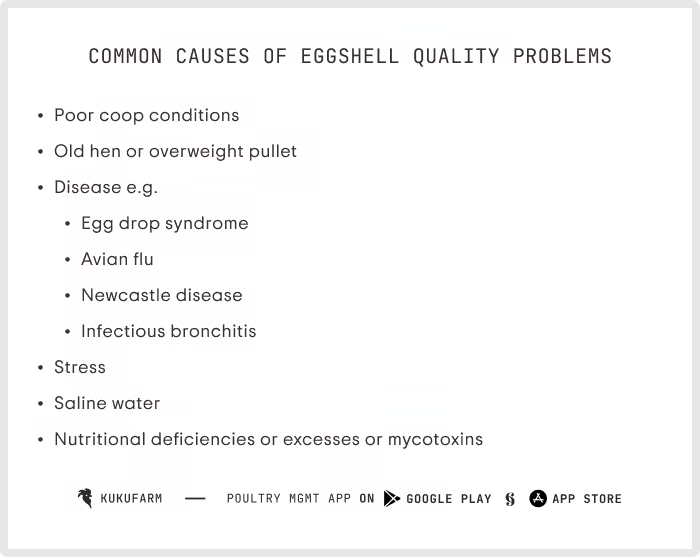There are a number of eggshell quality problems that you can observe on eggs. These problems can be caused by a number of factors including coop condition, hen age and disease.
In this article we will outline 19 eggshell quality problems and their causes as very well documented by Alltech. You may also be interested in how to manage poultry vaccination schedule using Kukufarm.

Eggshell quality problems
1. Pale shell
Appearance: Eggshell appears pale
Causes: Infectious bronchitis, egg drop syndrome, older hen, stress or use of chemotherapeutic agents such as sulphonamides and nicarbazin.
2. Lilac / pink shell
Appearance: Eggshell appears pink or lilac due to the association between cuticle and an extra calcium layer.
Causes: Stress or excess calcium ingestion.
3. Dirty shell
Appearance: Eggshell is stained with droppings
Causes: Contact with wet droppings, large amounts of indigestible elements in feed, poor gut health, electrolyte imbalance or saline water.
4. Blood stained shell
Appearance: Eggshell is stained with blood smears from a prolapsed cloaca, vent pecking, or cannibalism
Causes: Overweight pullets, pullets coming into lay, sudden, large increases in day length, poor hygiene in coop or egg packaging system.
5. Shell-less egg
Appearance: Eggshell is non-existent, egg is contained by a shell membrane.
Causes: Immature shell gland, diseases: Avian influenza, NDV, Infectious bronchitis, Egg drop syndrome, insufficient calcium, phosphorous, manganese, or vitamin D3.
6. Soft-shelled egg
Appearance: Eggshell is soft and easily deformable, only a thin layer of calcium is deposited on the shell membrane.
Causes: Excessive phosphorous consumption, heat stress, bird age – older hen, saline water or mycotoxins.
7. Cracked shell
Appearance: Eggshell has hair-line cracks, star cracks or large cracks.
Causes: Heat stress, saline water, bird age – older hen, insufficient calcium or vitamin D3 or mycotoxins.
8. Corrugated shell
Appearance: Eggshell has rough, corrugated surface.
Causes: Heat stress, saline water, bird age – older hen, insufficient calcium or vitamin D3 or mycotoxins.
9. Wrinkled shell
Appearance: Eggshell has thin creases and wrinkled surface.
Causes: Stress, infectious bronchitis, defective shell gland, or overcrowding.
10. Pimpled shell
Appearance: Eggshell has small lumps of calcified material; severity depends on foreign material present during calcification.
Causes: Bird age, strain of bird, or inadequate nutrition.
11. Calcium coated shell
Appearance: Eggshell contains an extra layer of calcium all over or at one end.
Causes: Defective shell gland, disturbances during calcification, or excess calcium consumption.
12. Calcium deposited shell
Appearance: Eggshell contains white, irregular spots
Causes: Defective shell gland, disturbances during calcification, or excess calcium consumption.
13. Speckled shell
Appearance: Eggshell contains white or brown speckles.
Causes: Defective shell gland, disturbances during calcification, or excess calcium consumption.
14. Mottled shell
Appearance: Eggshell appears mottled or glassy in translucent areas when placed in front of light – usually the result of the shell not drying out quickly.
Causes: High humidity in coop, disease or mycotoxins, manganese deficiency or
overcrowding
15. Body-checked shell
Appearance: Eggshell is cracked in the shell gland pouch and then repaired before lay.
Causes: Incorrect lighting, stress, bird age – older hen or overcrowding.
16. Broken and mended shell
Appearance: Eggshell contains a diagonal break that occurs during formation and is mended before lay.
Causes: Stress during classification.
17. Misshapen shell
Appearance: Eggshell is too small or too large, round instead of oval, or differs from normal shape.
Causes: Immature shell gland, diseases such as Avian influenza, NDV, Infectious bronchitis, Egg drop syndrome, stress or overcrowding.
18. White banded shell
Appearance: Eggshell contains an extra layer of calcium seen as a white band marking.
Causes: Stress, changes in lighting.
19. Slab-sided shell
Appearance: Eggshell is flattened – due to contact with another incomplete egg in the shell gland pouch.
Causes: Stress, changes in lighting or disease.
Common causes of eggshell quality problems
The afore listed eggshell quality issues can be caused by a number of factors. Typically, such factors include coop conditions, stress or disease, and nutritional deficiencies.

In order to prevent and mitigate for these eggshell quality issues you should implement flock management prescriptions provided to you by your flock supplier. Moreover, you should consult with a certified poultry vet for optimal outcomes.

You may also be interested in how to track your flock’s egg production rate with Kukufarm.

